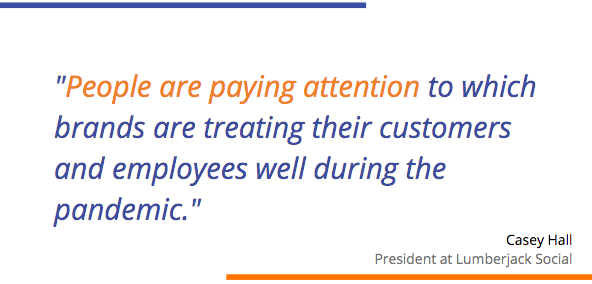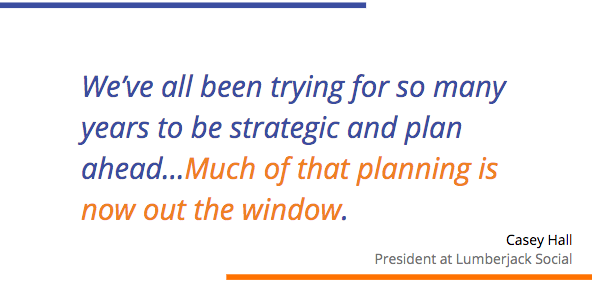The following is syndicated from our partner GaggleAMP’s blog, where Consultants Collective member, Casey Hall, shares his expertise in marketing messaging.
Your marketing messaging is more important than its ever been during the time of the coronavirus. If your marketing messaging comes off as somewhat insensitive, or as a hard sell despite the pandemic, people will remember that in a negative way. However, you can have the right messaging that is empathic, and genuinely helpful to your target audience, and that will leave a great impression.
But how do you go about that?
In this Q&A, Casey Hall, President of Lumberjack Social, a digital marketing agency specializing in social media, explains why marketing messaging is so important and what to keep in mind. He also gives tips on how you can deliver your message the right way, and what rules he likes to abide by.
Furthermore, Hall breaks down what your organization can do if it’s working remotely for the first time, and how you should prepare for an eventual return to normalcy.
Q: What are the biggest adjustments marketers need to make during this time?
Tone. It is more important than ever that marketers strike the right tone both in the words they choose and the content that they promote. Most brands made a correct decision to either go completely quiet or only put things out that talk about how they are helping during the pandemic.
But as this stretches on, some marketers are trying to be clever. It is particularly tempting to be clever if a business does offer a product or service that is legitimately more relevant now. If you are marketing something that is legitimately more relevant, I don’t think you need to call that out.
Everyone is aware of the pandemic. If you are selling something that people really need, you don’t need to remind anyone of why. My general rule is that you should not commingle any reference to COVID-19 with any explicit reference to your products.
-1.png?width=600&name=Conor%20Coughlan%20at%20Fernogo%20on%20ABX%20Marketing%20(3)-1.png)
Q: What should marketers do if event marketing was part of their budget and lead gen strategy heading into the year?
There have been some great responses from companies who have moved events online. While I think this is a good move, I haven’t seen these online events generating the same sort of pipeline opportunities as real-life events. Some budgets can be reallocated to online advertising, but that presents its own challenges in terms of tone.
I recommend getting personal. Use your time and resources that would have gone into events and instead reach out to customers and prospects individually. Ask them what they need, and find out how you can help. Focus less on how you can get a business to convert, and instead focus on how you can help that business survive so that you will have customers left when we get to the other side.
How should marketers pivot their marketing messaging?
Pivoting to some version of “we are all in this together” makes sense, but is at best, somewhat generic.
People are paying attention to which brands are treating their customers and employees well during the pandemic. Obviously, companies shouldn’t be acting responsibly solely for the purpose of brand affinity.
 But if your company is in a position to treat customers and employees generously, look for opportunities to go above and beyond what might be expected. If you can truly find ways to help others through this crisis, they will remember and let others know.
But if your company is in a position to treat customers and employees generously, look for opportunities to go above and beyond what might be expected. If you can truly find ways to help others through this crisis, they will remember and let others know.
Have you or a client had to make any adjustments in terms of marketing strategies or business processes?
Everyone has had to adjust to various degrees. Adjusting to uncertainty is the primary challenge that I’ve seen. We’ve all been trying for so many years to be strategic and plan ahead. We try to set up our marketing messaging months in advance so that we can have a really well-aligned program. Much of that planning is now out the window.
 Rather than trying to figure out what the perfect campaign will be in Q3, assuming that we are somewhat back to “normal,” companies can use this time to become more responsive and more nimble so that however this shakes out they are prepared to respond.
Rather than trying to figure out what the perfect campaign will be in Q3, assuming that we are somewhat back to “normal,” companies can use this time to become more responsive and more nimble so that however this shakes out they are prepared to respond.
This could mean developing your collection of approved messaging and creative assets so that you can very quickly deploy campaigns when the time is right, or simply learning to be more agile and figuring out ways to reduce the approval time to get things out the door.
How difficult is it for organizations to suddenly have a remote workforce? And what advice is there to adjust to this on the fly?
This is highly dependent on the level of investment companies have previously made in basic digital ‘literacy’ for their marketing and communications teams.
Those companies who had not gotten on board with collaboration, communication, and workflow tools and processes are facing a much bigger challenge. Many employees had simply never been exposed to using Slack, Zoom, or WebEx before.
It is totally understandable for those folks to shy away from using these tools and instead rely solely on phone calls and email. For some teams that might work, but for most, they will be missing out on a better work-from-home experience they could have if they were given the training and encouragement to utilize these tools.
———————
Marketers need to use their best judgment when it comes to finding their way to the other side of the pandemic. This is the first time anyone has gone through this, so no one knows for sure exactly how to go about their marketing strategy and their marketing messaging.
It’s not like there is an exact right answer. The best thing you can do is listen to others, take note of their advice, see what works for other people, and use your best judgment on what will work for your organization.








